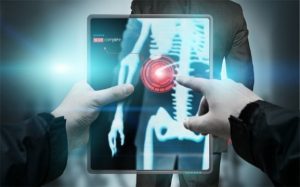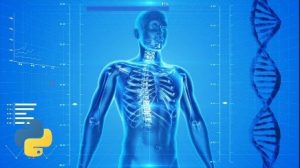Artificial Intelligence
20 May 2024
One of the objectives of the Cyborg Experimental Centre is knowledge management, in a broad sense, through innovative methodologies aimed at the acquisition of specific professional competences in the form of knowledge, skills, abilities, attitudes and teamwork, and developing both translational research and preventive strategies in health-electronics.
Nowadays, new technologies affect us in many areas of our lives and of course, the health sector, being a sector in constant change and evolution that needs the latest advances to provide the best services to its patients, is no stranger to all these new technologies.

Talking about the Medicine of the future means talking about technology, given that Medicine and Artificial Intelligence (AI) will inevitably go hand in hand from the moment we talk about the digitisation of processes. The complexity and increase in the amount of data used in medical care means that this technology has many and numerous applications, especially in clinical decision-making.
To this end, the Cyborg Experimental Centre offers training to medical professionals in one of the most powerful allies we have at our disposal, namely Artificial Intelligence.
This training is done by learning the Python programming language, which is the programming language of choice for the development of AI applications and systems.
Artificial intelligence is a technology based on the neural network model of the brain that allows various devices, through a series of algorithms and rules, to develop autonomous thoughts and decisions based on the data provided.
Artificial intelligence is marked by two concepts:
- Machine learning:It is understood as a branch of artificial intelligence based on the creation of systems that, applied to machines, are capable of interpreting an algorithm to identify large amounts of data, carry out its analysis and draw conclusions.
- Deep learning:We are talking about a more advanced level of Artificial Intelligence. At this level, machines can have autonomous behavior after processing data systems, that is, the machine learns by itself from the errors it receives. we can say that you can create a model that learns and prevents future errors.
We can easily find examples of Deep Learning in our daily life, such as speech assistants like Siri, Cortana or Alexa, systems with which you can have a conversation and make the device execute orders, autonomous cars, with obstacle recognition. and humans to stop or dodge, Platforms like Netflix or Amazon also use algorithms based on a user’s experience to issue recommendations… all of these are examples of star developments in Deep Learning.
Artificial Intelligence in Medicine

Artificial intelligence in medicine focuses its main utility on the great speed with which it processes large amounts of data, making this key for the analysis of different medical tests, allowing the analysis of all this data to carry out early diagnoses in the shortest possible time. .
Thanks to artificial intelligence we can obtain accurate diagnoses more quickly, reduce research times for the development of new drugs and the treatment of certain diseases and, of course, alleviate the workload for medical professionals.
Specifically, Artificial Intelligence is capable of describing and interpreting data, learning from it and applying algorithms to provide solutions. In other words, the patient could be recognized, their digital medical history reviewed at the moment, compared and guidelines given to the medical professional based on that background.
In this way, systems for the early detection of diseases or the monitoring of a treatment in real time are achieved. Useful systems that are included in the concept of “personalized medicine” and that can improve patient care.
AI applications in medicine
There are several ways in which AI can have a very positive impact on the practice of medicine, being able to help in decision-making or significantly accelerating scientific research. Let’s see some examples of how AI could be used:
- AI in the detection and diagnosis of diseases. –Machine learning models could be used to observe the vital signs of patients receiving intensive care and alert doctors if certain risk factors increase. The AI can collect the data from those devices and search for more complex conditions, such as sepsis. A trained algorithm can help reduce investigation time by providing clinicians with valuable search results with evidence-based information about treatments and procedures while the patient is still in the hospital room.
- Treatment of personalized diseases. –Because AI models can learn and retain preferences, AI has the potential to provide real-time personalized recommendations to patients 24 hours a day.
- Prominent role in the area of medical imaging. –AI powered by artificial neural networks, in addition to helping doctors detect the early signs of any disease, can also help manage, verify and analyze the large amounts of medical imaging that doctors must work with on a daily basis.
- Efficiency of clinical trials. –During clinical trials, significant time is spent assigning medical codes to patient outcomes and updating relevant data sets. AI can help speed up this process by providing a faster and smarter search for medical codes.
- Accelerated development in the development of new drugs. –Drug discovery is often one of the longest and most expensive parts of drug development. AI could help reduce the costs of new drug development mainly in two ways: better drug designs and finding promising new drug combinations.
- How to reduce health care costs. –AI could reduce costs in the healthcare industry. Like, for example, with the reduction of medication errors, personalized virtual health care, fraud prevention and support for more efficient clinical and administrative workflows.
Let’s see 2 real examples of Deep Learning applied to the field of Medicine and Health:

CORTI.-Application used by the Danish Emergency Services, it is a voice assistant whose task is to analyze the conversations between professionals and patients and thus extract the data, the system analyzes the conversation and detects clues that it later relates to its base of data.
All related information is then supplied to the emergency services. Thanks to Corti, many lives have been saved, since in emergency situations, patients are often under a lot of pressure. Both people in trouble and emergency services can be nervous. And that’s when information about symptoms and medical conditions is vital.
Radio.-AI has become one of the most powerful allies in the fight against cancer. This system was launched by the IT Department of the Moscow Government. It is an open source cancer detection code. This app uses Deep Learning to find signs of lung cancer on X-rays.
This is a cancer detection code, which is available on Github, and which uses ‘deep learning’ to find signs of lung cancer on X-rays. . According to the DIT, RadIO allows you to create deep learning algorithms in a short, easy-to-read piece of Python code. This system is so fast that, according to the researchers, it is capable of processing the x-rays of the entire population of Moscow (12 million people) in 30 seconds.
Python language and its implication in the development of deep learning

It is a multi-paradigm programming language, that is, valid for its application in different fields and that provides skills to link artificial intelligence with devices, machines and production objects, optimizing development efforts, as it is a simple and easy-to-use language. Open Source.
Two aspects that Python provides make it the indicated option for the implementation of Artificial Intelligence:
- Compatibilitywith the interpretive runtime, without standard compiler languages. This makes Python especially useful for prototyping algorithms for AI.
- An intuitive work approachIt’s perhaps its most recognizable feature, but when you add options for data structures and control capabilities, the results improve dramatically.
Python It can be used in countless activities and sectors such as artificial intelligence projects, to create websites, to perform complex structural calculations with finite elements, to design video games, to implement social networks, to create neural networks of systems that identify elements within an image, to language translation platforms…etc.
Such is its global impact that 57% of machine learning data scientists and developers use it and 33% prioritize it for development.
According to a study carried out in 2020 by the Inter-American Development Bank (IDB), it was estimated that medical data doubled every 73 days. This increase is equivalent to more than a million gigabytes of information or 300 million health books per person in their lifetime.
Faced with such a scenario, artificial intelligence in the field of medicine becomes a valuable tool for professionals in the area, by optimizing the processes of prevention, diagnosis and treatment of diseases.